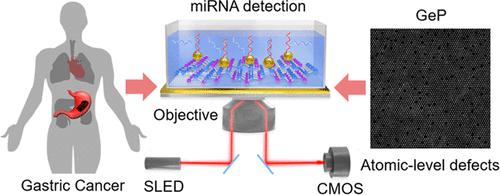用于胃癌诊断的 GeP 纳米生物传感器中的原子级缺陷工程
IF 16
1区 材料科学
Q1 CHEMISTRY, MULTIDISCIPLINARY
引用次数: 0
摘要
缺陷工程学通过创造丰富的化学活性位点,为提高生物传感材料的灵敏度提供了一种前景广阔的方法。尽管潜力巨大,但实现对这些缺陷的精确控制和修饰仍是一项重大挑战。在此,我们提出在 GeP 二维(2D)层状材料中进行原子级缺陷工程,然后在单个缺陷活性位点上精确地原位生长金纳米粒子,以设计超灵敏生物传感器。这种基于 GeP 的生物传感器具有出色的化学稳定性、灵敏度和选择性,而且检测限极低,仅为 28.6 aM,因此在 miRNA 检测方面表现突出。当应用于胃癌患者的临床组织样本时,该生物传感器有效地量化了 miR378c 生物标志物,实现了精确的分期监测。这项研究不仅是通过缺陷工程在生物传感材料领域取得的重要进展,还为癌症的早期诊断、分期和监测提供了一条前景广阔的途径。本文章由计算机程序翻译,如有差异,请以英文原文为准。

Atomic-Level Defect Engineering in GeP Nanoflake Biosensors for Gastric Cancer Diagnosis
Defect engineering offers a promising approach to enhance the sensitivity of biosensing materials by creating abundant chemically active sites. Despite its potential, achieving precise control and modification of these defects remains a significant challenge. Herein, we propose atomic-level defect engineering in GeP two-dimensional (2D) layered materials, following precise in situ growing Au nanoparticles on the single defect active sites for the design of ultrasensitive biosensors. The GeP-based biosensor exhibits notable capabilities for miRNA detection with excellent chemical stability, sensitivity, selectivity, and an extremely low detection limit of 28.6 aM. When applied to clinical tissue samples from gastric cancer patients, the biosensor effectively quantified the miR378c biomarker, enabling accurate stage-specific monitoring. This research not only represents a crucial advancement in the field of biosensing materials through defect engineering but also provides a promising avenue for early cancer diagnosis, staging, and monitoring.
求助全文
通过发布文献求助,成功后即可免费获取论文全文。
去求助
来源期刊

ACS Nano
工程技术-材料科学:综合
CiteScore
26.00
自引率
4.10%
发文量
1627
审稿时长
1.7 months
期刊介绍:
ACS Nano, published monthly, serves as an international forum for comprehensive articles on nanoscience and nanotechnology research at the intersections of chemistry, biology, materials science, physics, and engineering. The journal fosters communication among scientists in these communities, facilitating collaboration, new research opportunities, and advancements through discoveries. ACS Nano covers synthesis, assembly, characterization, theory, and simulation of nanostructures, nanobiotechnology, nanofabrication, methods and tools for nanoscience and nanotechnology, and self- and directed-assembly. Alongside original research articles, it offers thorough reviews, perspectives on cutting-edge research, and discussions envisioning the future of nanoscience and nanotechnology.
 求助内容:
求助内容: 应助结果提醒方式:
应助结果提醒方式:


